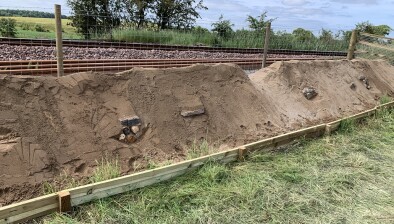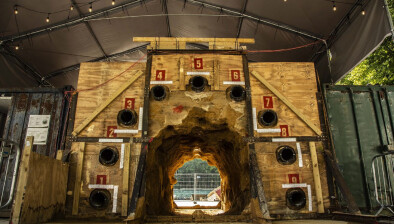And finally… Scotland’s most bashed rail bridges revealed
Two of Scotland’s railway bridges are among the 20 most bashed structures in Britain, according to new figures.

The Carlisle Road bridge in Cleland was struck 13 times in the 2019/20 financial year making it the seventh most struck bridge in Britain.
The bridge in Greenhills Road, Paisley, was the 14th most struck, having been hit by vehicles nine times in the year.
Data released by Network Rail shows that across Scotland as a whole there were 143 occasions when road vehicles hit rail bridges, out of a total of 1714 incidents across Britain.
This caused major disruption to road users and rail passengers in Scotland, with over 6,000 minutes of train delays and more than £460,000 in costs to the railway.
With the Black Friday and Christmas rush around the corner and more large vehicles expected on Britain’s roads, Network Rail is running a ‘lorries can’t limbo’ campaign to raise awareness and drivers are being urged to ’wise up and size up’ by knowing the height restrictions of their vehicle.
Throughout this period, reminders to ‘Wise Up, Size Up’ will feature on petrol pumps at motorway service stations across Britain along with posters, reminding drivers to check their routes before setting off.
Network Rail has also worked with industry bodies – including the Driver and Vehicle Standards Agency (DVSA ) – and hauliers for a number of years, leading a Bridge Strike Prevention Group to ensure companies and their employees are provided with the knowledge and tools they need to avoid striking bridges.
Although there has been an 11% decrease in incidents in the last financial year, including an 18% drop in Scotland, bridge strikes remain a dangerous and costly concern.
Sir Peter Hendy CBE, chair of Network Rail, said: “We’ve done a lot of work with partners across the industry in recent years to tackle bridge strikes, and whilst it’s encouraging to see our work is paying off with numbers now on the decline, there’s a lot more to be done to cut the unnecessary delays, costs and safety risks they pose.”
Gareth Llewellyn, DVSA chief executive, said: “There’s real headway being made and we’re seeing a drop in bridge strikes, but we must keep up this momentum to avoid these dangerous and costly incidents.
“You should ensure your drivers are doing their walkaround checks and noting the height of their vehicle every day. While DVSA can fall back on regulatory action to deal with bridge strikes, I’d prefer to see no incidents at all, with operators and drivers checking heights before every journey.”
Most struck railway bridges in Britain 2019/20:
- Watling Street Hinckley, Leicestershire: 25 strikes
- Bromford Road Dudley, West Midlands: 24 strikes
- St John’s Street Lichfield, Staffordshire: 23 strikes
- Stuntney Road Ely, Cambridgeshire: 19 strikes
- Abbey Farm Thetford, Norfolk: 16 strikes
- Thurlow Park Road Tulse Hill, London: 14 strikes
- Carlisle Road Cleland, North Lanarkshire: 13 strikes
- Harlaxton Road Grantham, Lincolnshire: 13 strikes
- Stonea Road Stonea, Cambridgeshire: 13 strikes
- Coddenham Road Needham Market, Suffolk: 11 strikes
- Lower Downs Road Wimbledon, London: 11 strikes
- Warminster Road Wilton, Wiltshire: 10 strikes
- Prescott Street Wigan, Greater Manchester: 10 strikes
- Greenhills Road Paisley, Renfrewshire: 9 strikes
- Newhouse Road South Ruislip, London: 9 strikes
- Kenworthy Road Homerton, London: 9 strikes
- St John’s Road Isleworth, London: 9 strikes
- Jews Lane Twerton, Somerset: 9 strikes
- Barrowby Road Grantham, Lincolnshire: 8 strikes
- Cambridge Road Hitchin, Hertfordshire: 8 strikes

















